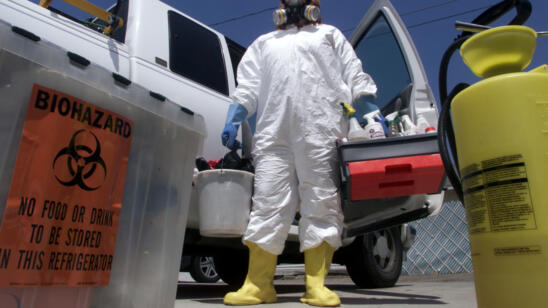Following an autopsy, investigators in North Carolina announced in February 2018 that 3-year-old Mariah Kay Woods had been killed by chloroform poisoning. Her mother’s boyfriend, 32-year-old Adolphus Earl Kimrey II, has been charged with the murder and has pleaded not guilty. His trial isn’t scheduled until February 2021.
If the idea of chloroform confuses you, you’re not alone.
“I’ve only ever heard of one other case in the [history of the] state of North Carolina,” Major Chris Thomas, who is leading the investigation into Woods’ murder for the Onslow County Sheriff’s Office, tells A&E True Crime. When asked specifically how and why his department believed Kimrey used the compound, Major Thomas declined to answer, noting that information would be divulged over the course of the trial.
How Chloroform Kills
Chloroform has been featured in crime fiction since the 19th century, but in those pulpy publications it’s erroneously presented as an instantaneous “knockout drug,” often applied via soaked rag in an alleyway ambush. In reality, chloroform-induced sedation requires careful and continuous dosing, says Nathan Lents, forensic biologist and professor at John Jay College of Criminal Justice.
When sedation is dosed correctly, the compound depresses function of the central nervous system, meaning that “you can knock out a person’s conscious awareness, and as long as you don’t go further, the autonomic functions are still intact,” Lents says. “That’s why your brain can still control your breathing, kidneys and visceral organs, which rely on information from the brain. But only if you get the dose right. At lower doses it knocks you out; at higher impulses it kills you.”
Lents says that the majority of chloroform-related deaths are the result of respiratory failure, although fatal cardiac arrhythmia can also occur.
The History of Chloroform Crime
Despite the popular perception of the drug as a harmless agent to unconsciousness, Mariah Kay Woods isn’t the first to perish under its effects.
In February 1993 physician Samson Dubria was convicted in a San Diego court for the murder and rape of his traveling companion, Jennifer Klapper, after the 20 year old was found dead in a California motel room in the summer of 1991. Dubria claimed that the sex had been consensual, and that any chloroform poisoning in his partner was a result of driving on the highway behind a truck carrying the substance. Dubria was sentenced to life in prison, That case is believed to be the first involving the use of chloroform in a murder.
In 2011 chloroform was in the news again, this time during the high-profile murder trial of Casey Anthony. The Orlando woman was accused of dosing her 2-year-old daughter, Caylee, with chloroform, suffocating her with duct tape and disposing of her body in the woods. But jurors in the case didn’t accept the prosecutors’ case and found Anthony not guilty.
More recently, in 2014, 39-year-old David Cooper was charged with killing his girlfriend, Sameena Imam with a chloroform-soaked tea towel after discovering the woman was having an affair with his brother, Roger. After his arrest, David Cooper told police that, “I have a bottle of chloroform, and because I’d seen it on telly and thought it was O.K., I thought ‘I’ll just shut her up,’ ” according to an audio interview between David Cooper and the police, featured on The Daily Mirror.
Roger was also charged and convicted in the case. Each brother received 30 years in prison.
Still, the cases are few and far between.
“It’s really overblown,” says Lents. “You would have to really go out of your way to kill yourself with chloroform. It absorbs in the skin very fast, but not in quantities that would kill you… I’ve spilled it on myself, and I’ve never even felt light-headed.”
But although rarely used for murder, chloroform is nonetheless dangerous and was historically responsible for hundreds of deaths due to misapplication, says Linda Stratmann, author of Chloroform: the Quest for Oblivion, which traces the history of the now-obsolete anesthetic.
Stratmann says chloroform first caught on in Scotland, where its medical application was pioneered by the physician Sir James Young Simpson in 1847.
“He used it on tooth extraction, he used it for childbirth. People thought it was great,” says Stratmann. “But then people started dying.”
The appeal of the drug, Stratmann says, was that it was less flammable and more pleasant smelling than ether, the popular anesthetic of the time. Lentz, who does lab work with chloroform, describes the odor as “very distinct…pleasant…a cross between citrus and acetone” (nail-polish remover).
Separating Fact from Fiction
As a magical knockout drug of the criminal underworld, chloroform’s effects were exaggerated and mythologized almost as soon as the drug hit the market, Stratmann argues, especially by those caught in compromising situations where they wished to absolve themselves of responsibility.
One of the earliest known examples of the chloroform story involved Londoner Frederick Jewett in 1851. A government official, Jewett claimed to have been unwittingly chloroformed while passing a young woman in the street who surprised him by waving a handkerchief in his face, rendering him unconscious. Jewett then awoke in the apartment of the woman—a prostitute—to find his watch, jewelry and money all stolen.
Even at the time, “Doctors said, ‘this is ridiculous,’ ” says Stratmann, adding that a far likelier story was that the gentleman had been robbed after consciously soliciting the prostitute, and had come up with the handkerchief anecdote to avoid embarrassment. Nonetheless, “It caught on.”
Meanwhile, the lethal nature of the drug remained real, something that today is largely forgotten.
In 1933, Stratmann says, nearly 300 people died on the operating table as a result of chloroform poisoning. Recognizing the danger of the substance, dentists and anesthesiologists moved on to nitrous oxide and other, safer drugs.
Today, the chemical has application in toxicology labs but no medical use, having long fallen out of favor.
Despite this, it’s easy to procure. Although synthesizing chloroform requires the sophisticated knowledge of a chemist, there is no permit necessary to purchase it, and the substance can be readily purchased at most chemical-supply stores.
But remember: Just because you can get your hands on it, doesn’t mean you can use it like they do in the movies.
“It’s very irresponsible for filmmakers to represent something that is lethal as something that is safe,” says Stratmann. “I’m not the kind of person to watch a film and say ‘Oh, that uniform is the wrong color.’ But chloroform is so dangerous. People shouldn’t imagine that what they see on the [TV] as right.”
Related Features:
Belle Gunness: The Early 20th Century Female Serial Killer You Probably Haven’t Heard Of
Clues From Beyond the Grave: When Victims Help Solve Their Own Murders
What It’s Really Like to Be a Crime-Scene Investigator
Casey Anthony: Read Complete Coverage


